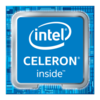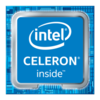Intel Celeron N5105 vs Intel Core i5-3439Y vs Intel Celeron N5095A
Intel Celeron N5105
► remove from comparison
Der Intel Celeron N5100 ist ein Anfang 2021 vorgestellter Quad-Core-SoC, der hauptsächlich in preiswerten und kleinen Desktops verbaut wird. Er taktet mit 2 bis 2,9 GHz (Einzelkern Burst) und gehört der Jasper-Lake-Plattform an. Die Fertigung erfolgt im 10nm Prozess bei Intel (wahrscheinlich wie Ice Lake). Neben den vier CPU-Kernen integriert der Chip auch eine DirectX-12-fähige Grafikeinheit mit 24 EUs und einem Takt von bis zu 800 MHz, sowie einen LPDDR4(x)-Speichercontroller (Dual-Channel, 2.933 MHz, 16 GB max.). Der SoC kann nicht ausgetauscht werden, da er direkt mit dem Mainboard verlötet wird (BGA Package).
Weiterhin integriert der Chip teilweise WLAN und kann kostengünstig mit Wi-Fi 6 (Gig+) ausgestattet werden. 8 PCIe Gen3 Lanes werden vom SoC nach aussen geführt und 14 USB 2.0/3.2 und 2 SATA 6.0 Anschlüsse können verbaut werden. Das Package des SoCs misst 35 x 24 mm und ist damit deutlich größer als beim Vorgänger (25 x 24 mm).
Architektur
Die Prozessor-Architektur der Jasper Lake SoCs wurde im Vergleich zum Vorgänger deutlich weiterentwickelt. Im Schnitt soll sich die Einzelkernperformance im Vergleich zu Goldmont Plus um 30% erhöhen (10 - 80% bei den SPECint und SPECfp Benchmarks).
Performance
Durch die schnellere Architektur sollte der Celeron N5105 etwas schneller sein als der alte Pentium N5030, aber noch hinter den Tiger Lake Quad-Core CPUs zurückliegen. Der N5105 bewältigt jedoch problemlos die meisten Alltagsanwendungen (Office, Browsing) und ist auch für moderates Multitasking geeignet.
Grafik
Die integrierte UHD Graphics Grafikeinheit bietet 24 EUs (Gen. 11 Grafikkerne wie Ice Lake) welche mit 450 - 800 MHz getaktet werden. Es werden bis zu 3 Bildschirme mit 4k60 Auflösung unterstützt
Leistungsaufnahme
Der gesamte SoC wird von Intel wie der Vorgänger mit einer TDP von 10 Watt spezifiziert (mobiler N5100 6 Watt und geringere Taktraten). Damit kann der Chip prinzipiell rein passiv gekühlt werden, jedoch sind auch Varianten mit Lüfter möglich.
Intel Core i5-3439Y
► remove from comparisonDer Intel Core i5-3439Y ist ein besonders stromsparender ULV-Prozessor (13 Watt TDP) aus dem 1. Quartal 2013, der auf der Ivy Bridge Architektur basiert. Die mit einem "Y" am Ende der Modellbezeichnung gekennzeichnete CPU ist insbesondere für den Einsatz in Tablets und Ultrabooks vorgesehen. Dank Hyperthreading können die 2 Kerne gleichzeitig bis zu 4 Threads bearbeiten. Die Fertigung erfolgt im Gegensatz zum Vorgänger Sandy Bridge, der noch in 32 Nanometer produziert wurde, in einem kleineren 22 Nanometer Prozess mit 3D-Transistoren. Die Taktrate liegt mit nur 1,5 GHz (maximaler Turbo: 2,1 GHz für 2 Kerne, 2,3 GHz für 1 Kern) deutlich unter normalen ULV-Modellen mit 17 Watt TDP.
Ivy Bridge ist ein Die Shrink der Sandy Bridge Architektur, der nur an wenigen Stellen verbessert wurde. Unter anderem werden nun PCI Express in der neuen Version 3.0 sowie DDR3(L)-1600 unterstützt. Keine Änderungen gab es beim Featureset, welches weiterhin beispielsweise die Verschlüsselungstechnik AES-NI, die Befehlssatzerweiterung AVX sowie Turbo-Boost 2.0 umfasst.
Die Performance des i5-3439Y dürfte im Schnitt nur knapp oberhalb des i3-3217U liegen, da die niedrige TDP nur selten die maximalen Turbo-Stufen erlaubt. Dennoch sollte die Leistung für alle Alltagsanwendungen ausreichen.
Für die Grafikausgabe zeigt sich die im Prozessor integrierte Intel HD Graphics 4000 mit 16 sogenannten Execution Units (EUs) verantwortlich. Mittels Turbo-Modus kann die Ausgangstaktrate von 350 MHz bis auf 850 MHz ansteigen.
Mit einer TDP von nur 13 Watt ist der i5-3439Y nochmals sparsamer als die normalen ULV-Modelle (17 Watt). Zudem lässt sich die TDP auf 10 Watt absenken (cTDP Down), was die Performance jedoch weiter mindert. Damit ist die CPU am besten für Ultrabooks oder Tablets geeignet.
Intel Celeron N5095A
► remove from comparison
The Celeron N5095A is an inexpensive quad-core SoC of the Jasper Lake product family designed for use in affordable SFF desktops and laptops. It features four Tremont CPU cores running at 2 GHz that Boost to up to 2.9 GHz with no thread-doubling Hyper-Threading technology in sight. A pretty basic iGPU is present as well.
The only difference between the N5095A and the N5095 is that the former comes with support for more proprietary Intel technologies such as the Smart Sound DSP, Wake on Voice and HD Audio.
Architecture and Features
Tremont brings many improvements over Goldmont Plus, the architecture that we know from the N5030 and myriads of other N-class CPUs. An up to 30% boost in single-thread performance is to be expected thanks to smarter prefetchers, branch prediction improvements and other refinements, according to Intel. These new chips are physically larger than their immediate predecessors as a result. Either way, this is still a "small" core rather than a "big" one according to ChipsAndCheese.
The Celeron has 1.5 MB of L2 and 4 MB of L3 cache and is compatible with DDR4-2933 and LPDDR4x-2933 memory or slower. Support for Intel CNVi Wi-Fi 6 modules is baked into the chip, as are 8 PCIe 3.0 lanes for NVMe SSD speeds up to 3.9 GB/s. USB 4 or Thunderbolt aren't supported however.
Please also note that the Celeron gets soldered to the motherboard (BGA1338 socket interface) for good and is thus not user-replaceable.
Performance
While we haven't tested a single system featuring the N5095A as of Sep 2024, we have done several reviews of computers/laptops powered by the N5095. CPU performance should be pretty much identical between the two. Therefore, we fully expect the chip to be about as fast as the Core i3-10110U, Core i3-1005G1, Celeron N5105 and also the Ryzen 3 3200U in multi-threaded workloads. Which is just enough for the most basic of tasks in late 2024.
Performance will get a significant hit if the power target is set to 10 W or 6 W instead of the Intel-recommended 15 W value.
Graphics
The DirectX 12.1-capable 16 EU UHD Graphics runs at up to 750 MHz and is in many respects similar to what Ice Lake CPUs come equipped with. This graphics adapter is capable of driving up to 3 SUHD displays simultaneously; HEVC, AVC, VP9, MPEG-2 and other popular video codecs can all be hardware-decoded. AV1 and VVC can't.
As far as gaming is concerned, it is reasonable to expect playable framerates in really old games (like Dota 2 Reborn) provided one sticks to lower resolutions such as HD 720p.
Power consumption
While most N-class chips have a 6 W long-term power target, the Celeron N5095A has a 15 W TDP to mimic much faster U-class Core processors. This isn't a great CPU for passively cooled designs.
The N5095A is built with the same 10 nm Intel process as Ice Lake-U processors for pretty unimpressive power efficiency, as of late 2024.
| Model | Intel Celeron N5105 | Intel Core i5-3439Y | Intel Celeron N5095A | ||||||||||||||||||||||||||||||||||||||||||||||||||||||||||||||||||||||||||||||||||||||||||||||||||||||||||||||||
| Codename | Jasper Lake | Ivy Bridge | Jasper Lake | ||||||||||||||||||||||||||||||||||||||||||||||||||||||||||||||||||||||||||||||||||||||||||||||||||||||||||||||||
| Series | Intel Jasper Lake | Intel Core i5 | Intel Jasper Lake | ||||||||||||||||||||||||||||||||||||||||||||||||||||||||||||||||||||||||||||||||||||||||||||||||||||||||||||||||
| Serie: Jasper Lake Jasper Lake |
|
|
| ||||||||||||||||||||||||||||||||||||||||||||||||||||||||||||||||||||||||||||||||||||||||||||||||||||||||||||||||
| Clock | 2000 - 2900 MHz | 1500 - 2300 MHz | 2000 - 2900 MHz | ||||||||||||||||||||||||||||||||||||||||||||||||||||||||||||||||||||||||||||||||||||||||||||||||||||||||||||||||
| L2 Cache | 1.5 MB | 512 KB | 1.5 MB | ||||||||||||||||||||||||||||||||||||||||||||||||||||||||||||||||||||||||||||||||||||||||||||||||||||||||||||||||
| L3 Cache | 4 MB | 3 MB | 4 MB | ||||||||||||||||||||||||||||||||||||||||||||||||||||||||||||||||||||||||||||||||||||||||||||||||||||||||||||||||
| Cores / Threads | 4 / 4 | 2 / 4 | 4 / 4 4 x 2.9 GHz Intel Tremont | ||||||||||||||||||||||||||||||||||||||||||||||||||||||||||||||||||||||||||||||||||||||||||||||||||||||||||||||||
| TDP | 10 Watt | 13 Watt | 15 Watt | ||||||||||||||||||||||||||||||||||||||||||||||||||||||||||||||||||||||||||||||||||||||||||||||||||||||||||||||||
| Technology | 10 nm | 22 nm | 10 nm | ||||||||||||||||||||||||||||||||||||||||||||||||||||||||||||||||||||||||||||||||||||||||||||||||||||||||||||||||
| max. Temp. | 105 °C | 105 °C | |||||||||||||||||||||||||||||||||||||||||||||||||||||||||||||||||||||||||||||||||||||||||||||||||||||||||||||||||
| Socket | BGA1338 | BGA | BGA1338 | ||||||||||||||||||||||||||||||||||||||||||||||||||||||||||||||||||||||||||||||||||||||||||||||||||||||||||||||||
| Features | DDR4-2933/LPDDR4x-2933 RAM, PCIe 3, GNA, MMX, SSE, SSE2, SSE3, SSSE3, SSE4.1, SSE4.2, VMX, SMEP, SMAP, EIST, TM1, TM2, Turbo, AES-NI, RDRAND, RDSEED, SHA | Turbo Boost 2.0, Hyper-Threading, Virtualization VT-x, VT-d, Trusted Execution, AES, Intel 64, Anti-Theft, My WiFi, Idle States, Enhanced SpeedStep, Thermal Monitorin, Execute Disable Bit | DDR4-2933/LPDDR4x-2933 RAM, PCIe 3, GNA, MMX, SSE, SSE2, SSE3, SSSE3, SSE4.1, SSE4.2, VMX, SMEP, SMAP, EIST, TM1, TM2, Turbo, SST, AES-NI, RDRAND, RDSEED, SHA | ||||||||||||||||||||||||||||||||||||||||||||||||||||||||||||||||||||||||||||||||||||||||||||||||||||||||||||||||
| iGPU | Intel UHD Graphics (Jasper Lake 24 EU) (450 - 800 MHz) | Intel HD Graphics 4000 (350 - 850 MHz) | Intel UHD Graphics (Jasper Lake 16 EU) (450 - 750 MHz) | ||||||||||||||||||||||||||||||||||||||||||||||||||||||||||||||||||||||||||||||||||||||||||||||||||||||||||||||||
| Architecture | x86 | x86 | x86 | ||||||||||||||||||||||||||||||||||||||||||||||||||||||||||||||||||||||||||||||||||||||||||||||||||||||||||||||||
| Announced | |||||||||||||||||||||||||||||||||||||||||||||||||||||||||||||||||||||||||||||||||||||||||||||||||||||||||||||||||||
| Manufacturer | ark.intel.com | ark.intel.com | ark.intel.com | ||||||||||||||||||||||||||||||||||||||||||||||||||||||||||||||||||||||||||||||||||||||||||||||||||||||||||||||||
| L1 Cache | 128 KB |
Benchmarks
Average Benchmarks Intel Celeron N5105 → 0% n=0
* Smaller numbers mean a higher performance
1 This benchmark is not used for the average calculation










